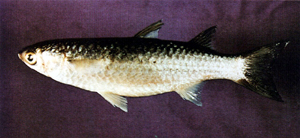

| Scientific Name |
|

by: Lab of Fish Ecol. and Evo., BRCAS |
|||||
| Author | (Valenciennes, 1836) | Depth | 0 - 20M | ||||
| Chinese | 綠背鮻 | Poisonous Fish | No | ||||
| Family_Chinese | 鯔科 | Economic Fish | Yes | ||||
| Family | F245 Mugilidae | Edible Fish | Yes | Chinese In Mainland China | 綠背鮻 | ||
| Max Length | 40 cm | Aquarium Fish | No | Common Name | 豆仔魚、烏仔、烏仔魚、烏魚、白鮻 | ||
| Distribution in World | India Ocean to West Pacific Ocean | Distribution in Taiwan | West、South、North、PonFu

|
||||
| Habitats | Coral、Benthos、Estuary、Fresh Water、 Coastal、Lagoon、Coral&Sand |
Holotype Locality | Ganges River, Malabar, India | ||||
| Synonyms |
Liza dussumieri, Liza macrolepis, Liza parmata, Liza parsia, Liza subvirdis, Liza subviridis, Liza vaigiensis, Mugil alcocki, Mugil dussumieri, Mugil javanicus, Mugil jerdoni, Mugil lepidopterus, Mugil ogilbyi ...all 19..
|
||||||
| Reference | 臺灣魚類誌(沈等, 1993);The Live Marine Resources of the Western Central Pacific, Vol.4(FAO,1999);Fish of Japan(Nakabo, 2002)
 褚耀鈺 1991 褚耀鈺 1991  沈世傑 編 Shih-Chieh Shen ed. 1993 沈世傑 編 Shih-Chieh Shen ed. 1993  Chen, M.-H., C.-W. Chang etc. 1997 Chen, M.-H., C.-W. Chang etc. 1997  Carpenter, K. E. etc. 1999 Carpenter, K. E. etc. 1999  Nakabo T. 2002 Nakabo T. 2002 
|
||||||
| Specimen List | |||||||
| Common Name | Red eye liza; Dussumier's mullet; Green back mullet; Greenback mullet | ||||||
| Redlist Status | |||||||
| Characteristic | Body fusiform or not distinctly deep. Head broad, but head depth usually equal to or greater than width; head dorsally flattened. Upper lip with an outer row of very small, close-set unicuspid teeth and 1 or 2 irregular, inner rows of smaller, villiform teeth. Lower lip directed forwards with 1 row of fine villiform teeth present or absent. Vomer edentate. Adipose eyefold moderately developed, covering up to 1 and 2 of iris. Gill rakers on lower limb of first gill arch 40 to 68, shorter than longest gill filaments. Origin of first dorsal fin midway between tip of snout and base of caudal fin, or just closer to latter; anal fin with III spines and 9 soft rays; caudal fin emarginate. Ctenoid scales in longitudinal series 28 to 32; 9 to 11 in transverse series; 7 or 8 scales in longitudinal series anterior to tip of pectoral fins and 19 or 20 anterior to origin of second dorsal fin; 16 or 17 in transverse series entirely around caudal peduncle. Body dark greenish dorsally, brownish over head, white ventrally; 3 to 6 indistinct, dark stripes along upper rows of scales; first dorsal fin greyish; second dorsal fin yellowish grey, with dusky margin; anal fin also with dusky margin; caudal fin bluish with black margin; pectoral fins yellowish and may have a blue spot at fin origin. 

|
||||||
| habitats | Forms schools in shallow coastal waters and enters lagoons, estuaries, and fresh water to feed. Juveniles may enter rice fields and mangroves. Feeds on small algae, diatoms and benthic detrital material taken in with sand and mud; fry take zooplankton, di | ||||||
| Distribution | Distributed in the Indo-Pacific from Red Sea to Samoa; north to Japan. It is a common species in Taiwan except eastern part. | ||||||
| Utility | Marketed fresh and salted. | ||||||





